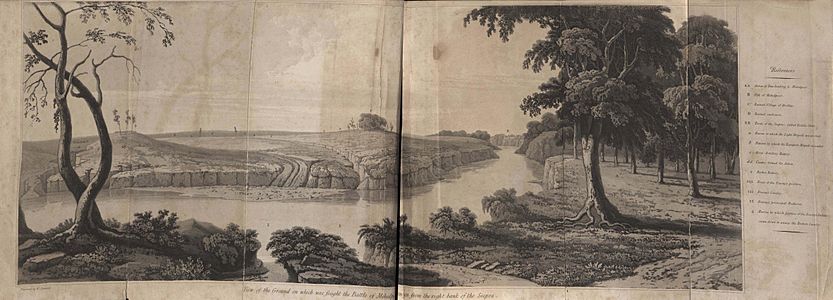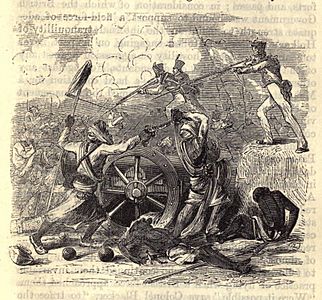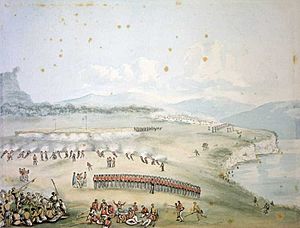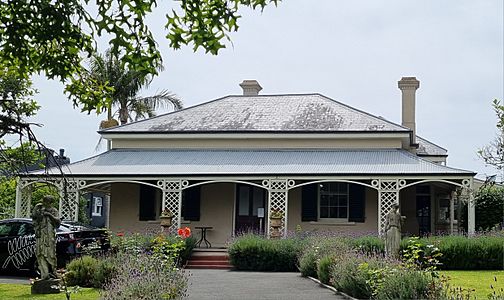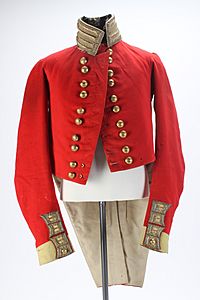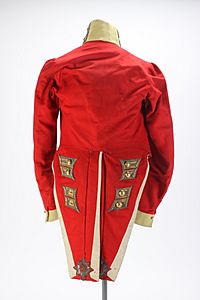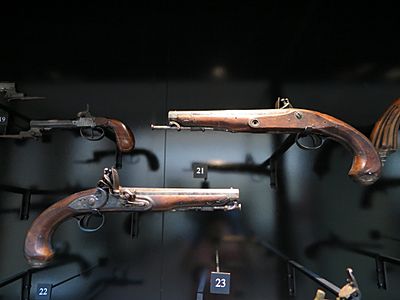William Hulme (British Army officer) facts for kids
Quick facts for kids
William Hulme
|
|
|---|---|
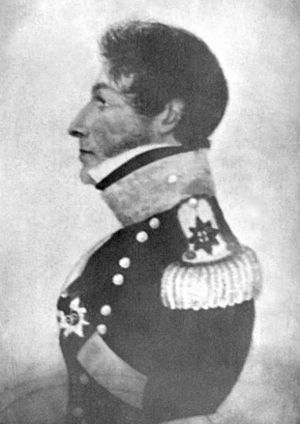
William Hulme, 96th Regiment of Foot
Auckland Libraries |
|
| Born | 10 May 1788 Halifax, Nova Scotia |
| Died | 21 August 1855 (aged 67) Auckland, New Zealand |
| Buried |
Symonds Street Cemetery, Auckland
|
| Allegiance | |
| Branch | |
| Years of service | 1803–1849 |
| Rank | Lieutenant Colonel |
| Unit | Nova Scotia Fencibles, 1803–
1st Regiment (Royal Scots), 1805– 7th Royal Fusiliers, 1822– 96th Regiment, 1824–49 |
| Commands held | New Zealand, 1844–45 |
| Campaigns | Third Anglo-Maratha War
Flagstaff War
|
| Awards | Army of India Medal, Maheidpoor clasp |
| Other work | Member, General Legislative Council of New Zealand, 1849 Justice of the Peace for the Province of New Ulster, 1849– Postmaster, Province of Auckland, 1854–55 Manager, Colonial Bank of Issue, Auckland |
Lieutenant Colonel William Hulme (born 10 May 1788 – died 21 August 1855) was an important officer in the British Army. He served with the 96th Regiment of Foot.
Contents
Early Life and Education
William Browne Hulme was born in Halifax, Nova Scotia, on 10 May 1788. He went to school at King's College in Windsor, Nova Scotia.
Military Career Highlights
After finishing college, Hulme joined the army. He became an ensign in the Nova Scotia Fencibles on 23 September 1803.
Service in the West Indies
In 1805, Hulme became a lieutenant and joined the 1st (Royal) Regiment of Foot. This regiment was stationed in the West Indies. His time there ended in December 1805. The regiment then returned to England.
Adventures in India
In 1807, Hulme's regiment was sent to India. They arrived in the Malay Peninsula in September. The soldiers moved around different parts of India. They helped keep peace and order.
In 1812, the regiment's name changed to the 1st Regiment of Foot (Royal Scots). They helped stop a mutiny (a rebellion by soldiers) in 1812. They also fought against groups called Pindari marauders.
Third Anglo-Maratha War
Around 1817, large armies were formed in India. Their goal was to stop the Pindari groups. They also wanted to deal with the rising Maratha Confederacy. William Hulme and his Royal Scots companies were part of this big army.
The Battle of Mahidpur
On 11 October 1817, Captain Hulme's companies marched to join the main army. They crossed the Narmada River on 30 November. On 12 December, they camped near Ujjain, close to Mahidpur.
On 14 December, they marched to Mahidpur. Here, the army of the Marahaja of Indore was waiting. After talks failed, the British prepared to attack.
On 22 December, Holkar's army was ready for battle. They had about 5,000 infantry soldiers and 76 cannons. Behind them were 30,000 horsemen. The British had fewer than 5,500 soldiers.
Hulme's companies led the attack. They crossed the Shipra River under heavy cannon fire. They charged forward with bayonets. They cleared the village of Dubli and forced the enemy to retreat. The battle lasted about two or three hours.
After the battle, Hulme was praised for his bravery. He was promoted to Brevet Major on 23 December 1817. The regiment received special honors for their actions. Years later, Hulme received the Army of India Medal for his part in the battle.
Service in New Zealand
In 1844, Lieutenant Colonel Hulme arrived in Auckland, New Zealand. He came with soldiers from the 96th Regiment of Foot. He took over command from another officer.
His time in New Zealand is well-known for his role in the Flagstaff War. This was the first major conflict between the British and Māori people.
The Flagstaff War
Otuihu Attack
In April 1845, Governor Robert FitzRoy declared martial law. This meant the military took control of the area. British ships and soldiers arrived at the Bay of Islands.
Hulme was ordered to attack rebel chiefs. On 29 April, his ships moved towards Otuihu. This was a fortified village (pā) belonging to a chief named Pomare.
When they arrived, a white flag was flying at Pomare's pā. Hulme sent interpreters to ask Pomare to meet him. Pomare refused at first. After a threat of attack, Pomare agreed to meet.
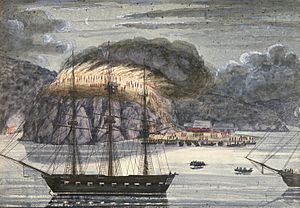
Alexander Turnbull Library
Hulme told Pomare that his actions were wrong. He said Pomare had to go on board the North Star ship. Pomare was taken as a prisoner to Auckland. Later that evening, Pomare's pā was burned.
Battle of Puketutu
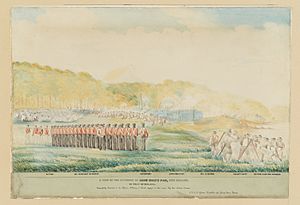
State Library of New South Wales
Hulme also led British forces during the attack on Hone Heke's pā at Puketutu. This pā was on the shores of Lake Ōmāpere.
On 7 May 1845, the British troops arrived at the pā. Hulme saw that the pā was very strong. The next day, they decided to attack head-on.
Heke's warriors fought fiercely from inside the pā. The British troops pushed forward. However, they could not break through the pā's strong defenses without cannons. Hulme decided to pull back his troops. He returned to Auckland.
Life After the Army
In 1846, William Hulme bought a house in Parnell, Auckland. This house is still known as Hulme Court today. It is one of the oldest houses in Auckland.
Retirement and Public Service
Hulme officially retired from the army in 1849. He then moved back to New Zealand.
In July 1849, Governor George Grey appointed Hulme to the General Legislative Council. This was a group that helped make laws for New Zealand. Hulme wanted to make it easier for European settlers to use Māori land for farming.
In 1854, Hulme became the first Postmaster for the Province of Auckland. This meant he was in charge of the mail service there.
Death and Legacy
William Hulme passed away on 21 August 1855. He was 67 years old. He was buried with military honors in Symonds Street Cemetery in Auckland. People remembered him as a brave soldier and an honest person.
-
Hulme Court, Parnell, Auckland, 2022.
-
96th Regt full dress coatee worn by Lt Col William Hulme.
Auckland Museum -
Cross belt and pouch worn by Lt Col William Hulme.
Auckland Museum -
A pair of Gill and Knubley flintlock duelling pistols, circa 1790, possibly owned by Lt Col William Hulme.
Auckland Museum


